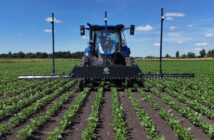A continuous flow drier with square bin storage had been in place for over 40 years at Robert Huddlestone’s Groves Farm at Howden, East Yorks, where Huddlestone Produce is based. Unsurprisingly, this grain drying and storage system was no longer reliable and lacked the capacity to cope with modern harvest demands. The time had come to upgrade and reap the benefits to the changes in permitted development rights.
“We harvest around 200h of wheat as a break crop to the swedes we grow for the wholesale markets,” explained Robert Huddlestone. “It was key that a new grain-drying and storage plant delivered the efficiency and productivity we needed so that harvest could be completed as quickly as possible. We can’t hold up work around our main crop of swedes which take up most of our time and manpower.”
Following discussions with McArthur Agriculture, Mr Huddlestone worked closely with Scott McArthur, director at McArthur Agriculture, with input from BDC Systems Ltd, on the options for a new plant to be designed to take full advantage of the change in legislation.
“Changes, made in 2018, mean that it is possible to construct an agricultural shed of up to 1,000sqm, a significant increase from 465sqm, without the requirement to submit a full planning application,” explained East Yorkshire-based Killian Gallagher of Gallagher Planning which works with farmers needing planning advice.
Less red tape
“The permitted development rights are still subject to a prior approval process, but the main benefit to farmers is this prior approval process has considerably less red tape than a standard planning application. Additionally, the entire process is cheaper, less complex and quicker,” added Mr Gallagher.
Mr Huddlestone obtained prior planning approval to construct a galvanised steel portal framed shed (42m long x 23.5m wide x 11.75m to the apex) with precast concrete grain walls.
McArthur Agriculture and BDC Systems designed the grain processing plant to optimise the permitted space, and deliver the required capacity to dry around 2,500t of wheat at 20tph when drying feed wheat from 20% moisture content (mc) down to 15%. The plant also had to operate with the existing 100Amp power supply.
The shed is divided into seven 6m bays. Bays 1-6 are for grain storage and bay 7 houses the intake, Skandia Elevator AB grain handling equipment and a Svegma SVC 4/4 continuous flow drier, both supplied by BDC Systems.

Skandia Elevator conveyor fills grain store
“We chose a Svegma drier, not only because of its proven track record, but as we have to finish harvest as quickly as possible it is likely that we will need to combine grain with a high mc,” explained Mr Huddlestone.
The Svegma has a lateral fixing system which means there are no fixings or ledges inside the grain column to hinder the grain flow, which is really important if the grain is coming in wet.
The grain enters the plant via a Skandia KTIG 20/40 40tph trench conveyor fitted into a hopper recessed in a concrete trench in the wet grain bunker.
The conveyor transports the grain to a pair of Skandia SEI 35/14 40tph belt and bucket elevators. The drier feed elevator is fitted with a Skandia dust and chaff remover to pre-clean the grain before it reaches the Svegma drier.
The dry grain is fed into the grain store by a Skandia KTIB 20/40 40tph curved chain and flight conveyor.
“Skandia conveyors were chosen not only because of their build quality, but Skandia’s range of section lengths and curve options allows for the design of a compact grain handling solution without compromising on reliability,” explained Andrew Head, BDC Systems’ Sales Director.
“This was crucial for Mr Huddlestone’s plant as to keep to the 1,000 sqm footprint the drier, grain handling system and control room had to be housed in one bay,” added Scott McArthur.
The plant was completed within the timescales set despite COVID lockdowns, and has easily kept up with the combine.




